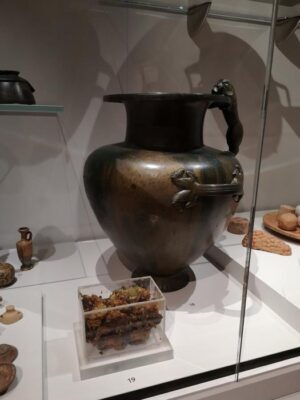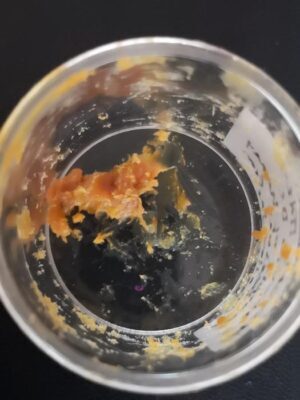
American Chemical Society—Decades ago, archaeologists discovered a sticky substance in a copper jar in an ancient Greek shrine. And until recently, the identity of the residue was still murky — is it a mixture of fats, oils and beeswax or something else? Researchers publishing in the Journal of the American Chemical Society have reanalyzed samples of the residue using modern analytical techniques and determined that it’s likely the remains of ancient honey — a conclusion previous analyses rejected.
Honey was an important substance in the ancient world, sometimes left in shrines as offerings to the gods or buried alongside the dead. In 1954, one such underground Greek shrine dating to around 520 BCE was discovered in Paestum, Italy — about an hour and a half’s drive from Pompeii. Inside were several bronze jars containing a sticky residue. At the time, archaeologists assumed it was honey, originally offered as honeycombs. Then, three different teams over the course of 30 years analyzed the residue but failed to confirm the presence of honey, instead concluding that the jars contained some sort of animal or vegetable fat contaminated with pollen and insect parts. But when the residue came to the Ashmolean Museum for an exhibition, a team of researchers led by Luciana da Costa Carvalho, James McCullagh had a chance to reexamine the mystery substance and collect new scientific evidence.
The researchers analyzed samples of the residue using several modern analytical techniques to determine its molecular makeup. They found that:
- The ancient residue had a chemical fingerprint nearly identical to that of modern beeswax and modern honey, with a higher acidity level that was consistent with changes after long-term storage.
- The residue’s chemical composition was more complex than that of the heat-degraded beeswax, suggesting the presence of honey or other substances.
- Where the residue had touched the bronze jar, degraded sugar mixed with copper was found.
- Hexose sugars, a common group of sugars found in honey, were detected in higher concentrations in the ancient residue than in modern beeswax.
- Royal jelly proteins (known to be secreted by the western honeybee) were also identified in the residue.
These results suggest that the ancient substance is what is left of ancient honey. However, the researchers can’t exclude the possibility that other bee products may also be present.
“Ancient residues aren’t just traces of what people ate or offered to the gods — they are complex chemical ecosystems,” explains da Costa Carvalho. “Studying them reveals how those substances changed over time, opening the door to future work on ancient microbial activity and its possible applications.”
____________________________

This bronze jar on display at the Ashmolean Museum contained a mysterious substance (shown in the foreground) that is very likely ancient honey. Adapted from the Journal of the American Chemical Society 2025, DOI: 10.1021/jacs.5c04888
____________________________

This is likely what 2,500-year-old honey looks like, according to new tests using modern techniques. Luciana da Costa Carvalho
____________________________
The American Chemical Society (ACS) is a nonprofit organization founded in 1876 and chartered by the U.S. Congress. ACS is committed to improving all lives through the transforming power of chemistry. Its mission is to advance scientific knowledge, empower a global community and champion scientific integrity, and its vision is a world built on science. The Society is a global leader in promoting excellence in science education and providing access to chemistry-related information and research through its multiple research solutions, peer-reviewed journals, scientific conferences, e-books and weekly news periodical Chemical & Engineering News. ACS journals are among the most cited, most trusted and most read within the scientific literature; however, ACS itself does not conduct chemical research. As a leader in scientific information solutions, its CAS division partners with global innovators to accelerate breakthroughs by curating, connecting and analyzing the world’s scientific knowledge. ACS’ main offices are in Washington, D.C., and Columbus, Ohio
___________________________
Article Source: American Chemical Society news release
*A Symbol of Immortality: Evidence of Honey in Bronze Jars Found in a Paestum Shrine Dating to 530-510 BCE, Journal of the American Chemical Society, 30-Jul-2025. 10.1021/jacs.5c04888




